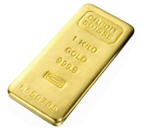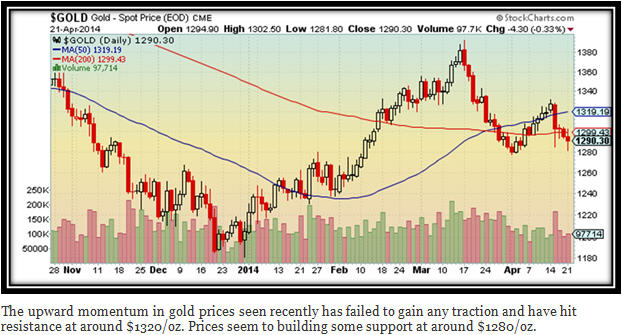Dubai emerges as a global gold centre as demand for bullion continues despite bearish reports from most western analysts
 Even though the price of gold has fallen below the psychological level of $1330 an ounce, and while the mainstream media continues with its consistently negative coverage, demand for physical gold remains extremely robust in certain regions.
Even though the price of gold has fallen below the psychological level of $1330 an ounce, and while the mainstream media continues with its consistently negative coverage, demand for physical gold remains extremely robust in certain regions.
One of these regions is the Middle East and the one centre that always fascinates me is Dubai. And, I am not surprised that business in Dubai has increased substantially. From what I see and hear, people in this region have no interest in what analysts at the major banks have to say about gold nor do they pay any attention to what Western main stream media has to report on gold. They are also not interested in the fact that Hedge funds in the West have trimmed their net long positions in gold. What is important to them is ownership of physical gold.
From my personal observation of the activities in the main gold souks, things are very busy and when it comes to the global gold market, and according to Ahmed bin Sulayem, Executive Chairman of Dubai Multi Commodities Centre (DMCC), Dubai has become a major global gold and precious metal trading hub.
“Dubai has quickly emerged as the leading global hub for the precious metals trade. As a result of DMCC’s continuous efforts to realise the vision of His Highness Shaikh Mohammed bin Rashid Al Maktoum, Vice-President and Prime Minister of the UAE and Ruler of Dubai, the emirate has risen as the destination for global precious metals trading,” Sulayem said in his keynote address at the Third Dubai Precious Metals Conference.
In 2013, almost 40% of the world’s physical gold trade came through Dubai and the value of total gold traded through Dubai grew to $75 billion, compared to $6 billion in 2003, and $70 billion in 2012. This is truly incredible considering Dubai does not produce the yellow metal.
Dubai also saw an annual trade volume increase of 73% accounting for 2,250 tons of gold, Sulayem said. “This market has proven to be resilient under all conditions; even on a year where total global demand fell by 15%. Dubai gained from near-record consumption demand growth. These figures represent a significant shift in the balance of global demand flows with Dubai positioned as one of the global market leaders,” the DMCC chief said at the conference.
Meanwhile, the Dubai Gold and Commodities Exchange (DGCX) plans to introduce a spot gold contract this June as part of its growth as a top trading centre for the precious metal, its’ chief executive Gary Anderson said. “The DGCX is in the final stages of finalising contract specifications,” a spokesman quoted Anderson at the conference.
The contract is expected to be for one kilogramme (32 troy ounces) of 0.995 purity gold, the spokesman added. The DGCX already trades gold futures.
The latest trading figures disclosed by the DMCC also highlighted Dubai’s growing reputation as the global bullion centre, ideally located between the producing and consuming nations.
In Japan, demand for physical gold soared in recent weeks, as the government pumped up their sales tax. Japanese gold bars and coins investment demand rose sharply by five-fold ahead of nation’s consumption tax hike that went into effect this month.
According to Forbes Asia, the China Gold Association showed that China’s gold consumption increased by 41% over 2012 to 1,176 tons in 2013. (China does not publish official numbers so discrepancies range in the hundreds of tons) Adding these imports to China’s domestic production of 428 tons indicates that China accumulated at least 1,604 tons last year.
Furthermore, combining China’s aggregate domestic production and apparent imports indicates that China has more than 3,514 tons, making it the world’s second largest national owner after the United States, if one can believe that the US still owns any gold.
In a report from Reuters, published on April 21, China has begun allowing gold imports through its capital Beijing.
Beijing is 3rd mainland gold import point, after Shenzhen & Shanghai and the opening of a third import point after Shenzhen and Shanghai could threaten Hong Kong’s pole position in China’s gold trade, as the mainland can get more of the metal it wants directly rather than through a route that discloses how much it is buying.
The People’s Bank of China (PBOC) is believed to be adding to its gold reserves, according to the World Gold Council (WGC), as it looks to diversify from U.S. Treasuries. The central bank rarely reveals the numbers.
Gold has traditionally been imported from Hong Kong into Shenzhen, where nearly 70 percent of the Chinese gold jewellery business is located. Shanghai was opened up as a second port last year.
Only banks are allowed to import gold into China. Industrial and Commercial Bank of China Ltd, Agricultural Bank of China Ltd, ANZ and HSBC are among the 12 banks that can import gold.
In addition to China and India, Indonesia, Saudi Arabia and Thailand increased their gold holdings in 2013. As gold is a widely recognized representation of wealth, this represents a massive transfer of ‘real’ wealth from West to East.
And, while the official figure shows that India’s imports were 978 tons last year, the figure does not take into account the massive quantities that were smuggled into the country.
As I have mentioned countless times, one of the reasons for owning gold is to protect your wealth against the depreciating value of fiat currencies. One example is the Ukrainian Hryvnia. It has been in free fall in 2014 and is the world’s worst performing currency this year.
The Hryvnia was relatively stable until 2014, when the currency collapsed from 0.12 to 0.08 since the start of this year. At the same time, the price of gold in Hryvnia went from 10,000 to 17,444 last week.
One could easily observe that this is an example of runaway inflation, even hyperinflation. In such a situation, gold is known to hold its value. It proves that people do not hold gold to have more value in terms of a currency. Rather, one holds gold as monetary insurance to preserve its purchasing power when things turn out bad.
TECHNICAL ANALYSIS
About the author
David Levenstein is a leading expert on investing in precious metals . Although he began trading silver through the LME in 1980, over the years he has dealt with gold, silver, platinum and palladium. He has traded and invested in bullion, bullion coins, mining shares, exchange traded funds, as well as futures for his personal account as well as for clients.
His articles and commentaries on precious metals have been published in dozens of newspapers, publications and websites both locally as well as internationally. He has been a featured guest on numerous radio and TV shows, and is a regular guest on JSE Direct, a premier radio business channel in South Africa. The largest gold refinery in the world use his daily and weekly commentaries on gold.
David has lived and worked in Johannesburg, Los Angeles, London, Hong Kong, Bangkok, and Bali.
For more information go to: www.lakeshoretrading.co.za
Information contained herein has been obtained from sources believed to be reliable, but there is no guarantee as to completeness or accuracy. Any opinions expressed herein are statements of our judgment as of this date and are subject to change without notice.
More News
{{ commodity.name }}
{{ post.title }}
{{ post.date }}


Comments